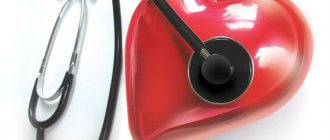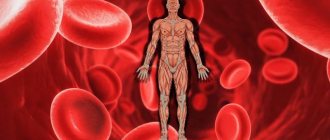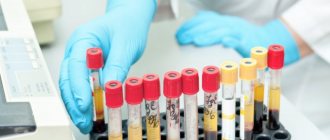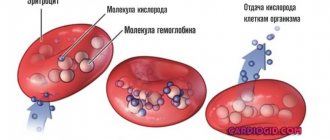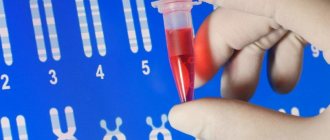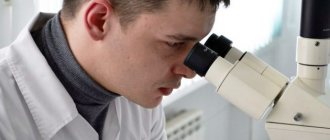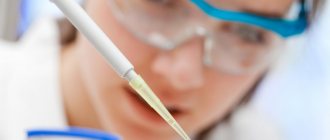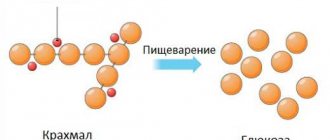Creatine kinase-MB (CK-MB) is one of the forms of creatine kinase that is found in the heart muscle. There are three types of creatine kinase enzyme, different in structure:
- CPK-MM (found in skeletal muscle and heart)
- CPK-MB (found primarily in the heart, but small amounts are also present in skeletal muscle)
- CPK-BB (mainly in the brain and smooth muscles such as the intestines and uterus)
Creatine kinase is released from muscle cells and is found in the blood whenever muscle damage occurs. The small amount of enzyme that is usually found in the blood mainly belongs to the CPK-MM fraction. CPK-BB almost never enters the bloodstream, and CPK-MB is usually present in significant quantities only when the heart is damaged. Therefore, a blood test for CK-MB is more specific for diagnosing myocardial infarction and other cardiac pathologies compared to a test for total creatine kinase. Typically, CPK-MB is performed as a control test for elevated total creatine kinase in order to determine what causes its increase.
What do the test results mean?
Normally, CK-MB is usually not detected in the blood or has a very low value.
Elevated levels of CPK-MB in combination with increased total creatine kinase and symptoms of a heart attack may indicate a recent myocardial infarction. If the concentration of CPK-MB falls and then increases again, we can talk about a second heart attack or long-term damage to the heart muscle.
CPK-MB increases not only with a heart attack, but also with any other damage to the myocardium - from trauma, surgery, inflammation, decreased oxygen levels (for example, with coronary heart disease), increased physical activity, as well as with renal failure, low hormone levels thyroid gland and alcohol abuse. Therefore, despite the fact that this analysis is more specific compared to measuring total CPK, it is still not suitable for the accurate diagnosis of myocardial infarction. A troponin test is used to establish an accurate diagnosis.
Creatine kinase
Creatine kinase (creatine phosphokinase, CPK) is an active protein, an enzyme that accelerates the reaction of transfer of a phosphoryl residue from ATP (adenosine triphosphate, a molecule that provides energy in the biochemical processes of the body) to creatine. This produces creatine phosphate and ADP (adenosine diphosphate). Thanks to this bioenergetic process, a large amount of energy is quickly released and muscle contraction occurs. Creatine kinase is contained in skeletal muscles, myocardium, smooth muscles, and the brain.
There are creatine kinase contained in mitochondria (intracellular structures) and cytoplasm (internal contents of cells, not including the nucleus). The enzyme molecule contains two components:
- M – from the English word “muscle”;
- B – from the English word “brain”.
The total creatine kinase studied in this test includes three isoforms that have important diagnostic value:
- muscle (KK-MM) present in skeletal muscles;
- cardiac (CC-MV), contained mainly in the cells of the heart muscle;
- brain (CC-BB), which contains cells of brain tissue and, in small quantities, other cells of the body.
Normally, the content of creatine kinase in the blood is insignificant (the main part is represented by the skeletal muscle isoform MM). The concentration of the enzyme in the body of children is higher than in adults. This is explained by the fact that the child’s body is in a state of increased growth. Nervous and muscle tissues, which contain large amounts of creatine kinase, are actively involved in this process. CK levels in men are slightly higher than in women.
Damage to cells containing the enzyme leads to an increase in its concentration in the blood. Based on the level of which isomer increases, a conclusion is made about damage to a particular tissue:
- in case of muscle damage - MM isoforms;
- in case of myocardial damage - MB isoforms;
- in oncological diseases - BB isoforms.
Therefore, to make an accurate diagnosis, it is necessary to examine the level of total creatine kinase and its isomers (usually the amount of the CF fraction is measured).
Based on the above, analysis of the concentration of creatine kinase allows us to identify the presence of both primary ones, caused by ischemia, inflammatory or dystrophic processes, injuries, and secondary ones, resulting from metabolic disorders, poisoning, intoxication:
- heart lesions;
- muscle damage;
as well as malignant tumors.
Destruction of heart muscle cells occurs:
- in case of myocardial infarction - an acute form of coronary heart disease, in which the delivery of blood to one of its parts is completely stopped and causes the death of this area in the absence of blood supply for 15-20 minutes;
- with myocarditis - inflammation of the myocardium of various etiologies (for example, due to the use of drugs, infectious diseases, etc.), accompanied by destruction of the muscle cells of the heart;
- with myocardial dystrophies - non-inflammatory damage to the heart muscle, characterized by metabolic disorders in it under the influence of extracardiac factors;
- with toxic myocardial damage.
Enzyme level testing is most often used to diagnose myocardial infarction. The concentration of CPK increases within 4 hours after the onset of the attack, the maximum level is observed after 1-2 days. The activity of the enzyme begins to weaken, starting from 3-4 days, gradually returning to normal. Since a heart attack requires immediate treatment, its timely diagnosis is very important for the patient.
Destruction of muscle cells is observed:
- with myositis (inflammatory processes in one or more skeletal muscles);
- with myodystrophy (muscular dystrophy - a congenital or acquired pathological condition characterized by progressive muscle weakness);
- for injuries (especially when compressed);
- when bedsores appear;
- for tumors;
- during intense muscle work (including during cramps).
The activity of creatine kinase depends on the concentration of hormones produced by the pancreas: the higher their level, the lower the activity of the enzyme and vice versa.
An increase in the level of total creatine kinase does not allow a clear diagnosis of any disease, so the test result must be interpreted by a specialist. At the same time, the clinical picture and the results of additional studies are taken into account.
Standard tables
The concentration of creanite kinase depends on the patient's gender and age. To a lesser extent race, origin.
Among women
| Age (years) | CPK level (units/l) |
| 15-20 | 123 |
| 21-50 | up to 150 |
| Over 50 | No more than 160 |
The calculations are approximate. In fact, you need to take into account the individual characteristics of the body, body constitution, height, weight, general health and others.
Only a specialist can cope. When he clarifies all the necessary points. This is possible during a face-to-face appointment.
In men
In men, the CPK norm in a blood test is initially two times higher than in women and ranges from 270 to 300 U/liter.
Why is that? The reason is that the total muscle volume is greater and the force of muscle contraction is greater. This is due to hormonal characteristics and body constitution. Therefore, energy metabolism goes faster.
| Age (years) | CK norm in units per liter of blood |
| 15-20 | 270 |
| 21-50 | Not higher than 300 |
| After 50 | Less than 280 |
It is impossible to say more precisely for the same reasons.
In children
CPK levels in the blood of children vary, but there is still no significant variation in gender. At birth, the rates are highest, and over time they fall by 2-3 times.
Detailed data is presented in the table:
| Years | Enzyme concentration (maximum) |
| First week | 650 |
| Up to 6 months | 295 |
| Up to 1 year | 200 |
| 1-3 years | 230 |
| 4-6 years | 150 |
| 6-12 years (during adolescence and early puberty, differences in gender become more noticeable, average values are given) | 160 (w), 250 (m) |
| 13-15 years old | 125 (w), 270 (m) |
Levels are approximate. It is better to leave the decoding to a specialist. The question is complex. There are no universal indicators.
Reasons for the increase
An increase in CPK concentration is more common than a decrease. Basically, such a deviation begins with degenerative processes.
- Myocarditis. Inflammatory damage to the heart muscle. It has an infectious, less often non-septic nature. Creatine kinase in the blood is elevated due to tissue destruction. The enzyme passes from bound to free form and is found in the blood in large volumes.
Normally, the level of CPK MB is about 2% of the total amount of creatine phosphokinase. The severity of the disease is judged by the concentration of the substance and the degree of deviation from the norm.
- The same goes for a heart attack. This is an emergency condition in which the muscle layer is rapidly destroyed from lack of nutrition and cellular respiration. A sharp increase in CPK is observed immediately after the pathological process has developed.
Then the level gradually decreases. This takes more than one day, but sometimes even several weeks. Doctors can help correct energy metabolism. If you systematically use protectors and other medications, recovery will go faster.
- Autoimmune muscle damage. Quite a rare occurrence. In this condition, the body's muscles are destroyed by its own defense system. The degree of disorder varies. In the mildest cases it is a localized process. In more complex ones - generalized. When many muscles are involved.
CPK MM enters the bloodstream, the concentration increases, this immediately becomes noticeable. Moreover, this modification makes up the vast majority of the total mass of the compound in the channel.
- What are the reasons why the blood sugar level jumps, what it entails, and how to relieve the condition
- The reason why creatine kinase in the blood is elevated may also be a stroke, an acute disorder of cerebral circulation. The essence of the phenomenon is approximately the same as during a heart attack. Only the localization is different. Parts of the brain die.
CPK BB, a specific isoenzyme found in nerve fibers, does not increase. The blood-brain barrier interferes.
However, due to violations of the central regulation of energy exchange processes, the number of other CPK modifications changes. This is rather an indirect consequence, but it is clearly noticeable. Everything returns to normal after a few weeks.
- Consuming large amounts of alcohol. An increase in creatine phosphokinase means that intoxication has occurred, and the stronger the poisoning, the more seriously energy metabolism suffers.
The study is carried out twice. The first time is before treatment begins (detoxification measures). The second one comes after. To investigate how much ATP synthesis has been restored.
You can evaluate the level later, in dynamics. This is important if, for example, the patient received critically dangerous poisoning, and it was barely possible to return him to normal. The question remains at the discretion of specialized doctors.
- Use of certain drugs. CK may also increase when taking certain medications - this is a side effect. Usually it does not pose a serious danger, but exceptions to the rule are possible. The same effect occurs with psychotropic drugs. Antidepressants, neuroleptics. To a lesser extent with tranquilizers.
- Another reason for increased creatine kinase in the blood is a recent operation. The more severe the intervention, the more difficult the recovery, the more serious the disturbances in energy metabolism. The main sign of this is an increase in creatine phosphokinase.
CPK may be higher than normal due to the destruction of muscles, nerve tissue, and myocardial structures. In each case, a certain fraction of the enzyme grows. Except perhaps for the brain, since the substance cannot leave the blood-brain barrier.
To determine what's wrong, you need to conduct a full diagnosis. A group of specialists should deal with this: a neurologist, a cardiologist and others.
Attention:
The increase in CPK does not help the body at all, and does not add health. Although it may seem so at first glance.
The fact is that increasing concentration does not increase energy metabolism in itself. Most often, enzyme fractions are released during tissue destruction. Nervous, muscular.
- Blood sugar 6.3: what to do when tests give such an indicator?
They act as a kind of depot, storage facility. During destruction, active release occurs. But the substances remain inactive. They have nothing to speed up. There is no more substrate.
In addition, the underlying disease itself may be a factor in insufficient energy metabolism. A paradoxical situation arises: CPK in the blood is elevated, and the process is extremely slow.
Creatine phosphokinase CPK-MB
Creatine kinase MB is an intracellular enzyme that is a specific and sensitive indicator of myocardial damage.
Research method
Linked immunosorbent assay.
Units
U/L (unit per liter).
What biomaterial can be used for research?
Venous blood.
How to properly prepare for research?
- Do not eat for 12 hours before the test.
- Avoid physical and emotional stress 30 minutes before the test.
- Do not smoke for 30 minutes before donating blood.
General information about the study
Creatine kinase MB (CK-MB) is an isoform of the enzyme creatine kinase involved in cellular energy metabolism.
While the CK-MM and CK-BB isoforms predominate in muscle and nervous tissue, creatine kinase MB is almost exclusively found in cardiac muscle. In the blood of a healthy person it is present in very small quantities. Therefore, an increase in creatine kinase MB activity is a highly specific and sensitive indicator of myocardial damage.
Myocardial damage can occur due to a variety of factors, such as trauma, dehydration, infectious disease, exposure to heat and cold, and chemicals. However, its main cause is atherosclerosis of the coronary vessels and coronary heart disease (CHD).
There is a direct relationship between the activity of creatine kinase MB and the extent of the infarction, so this indicator can be used in making the prognosis of the disease.
Ischemic myocardial injury that does not lead to infarction (eg, stable angina) generally does not increase creatine kinase MB activity.
Some substances have a direct toxic effect on the myocardium: alcohol intake promotes a 160-fold increase in the activity of creatine kinase MB, acute and chronic carbon monoxide poisoning CO – a 1000-fold increase.
Little activity (less than 1%) of creatine kinase MB is observed in muscle tissue. Therefore, during extremely high physical exertion (for example, marathon running) or with extensive trauma to skeletal muscles, the activity of creatine kinase MB may increase slightly without causing damage to the myocardium.
When is the study scheduled?
- For symptoms of acute coronary syndrome: intense chest pain lasting more than 30 minutes, not eliminated by nitroglycerin, weakness, sweating, shortness of breath with minimal physical activity.
- With symptoms of acute coronary syndrome without characteristic changes in the electrocardiogram.
- For symptoms of acute (and chronic) myocarditis: indistinct chest pain, increased fatigue, a feeling of interruptions in the functioning of the heart.
- When monitoring myocardial function in the early post-infarction period.
- When assessing the degree of myocardial damage and when making a prognosis of the disease, including exposure to large and prolonged exposure to small doses of ethanol and carbon monoxide.
What do the results mean?
Reference values: 0 - 25 U/l.
Reasons for increased activity of creatine kinase MB:
- acute myocardial infarction,
- acute and chronic myocarditis,
- blunt chest trauma,
- significant physical activity,
- injury with muscle damage,
- rhabdomyolysis,
- Duchenne muscular dystrophy,
- systemic connective tissue diseases (dermatomyositis, systemic lupus erythematosus),
- Reye's syndrome
- hypothyroidism,
- renal failure,
- carbon monoxide poisoning,
- congestive heart failure, cardiomyopathies,
- use of doxycycline.
A decrease in creatine kinase MB activity is not diagnostically significant.
What can influence the result?
- Previous myocardial pathology, heart failure.
- Taking drugs that lower the glomerular filtration rate: furosemide, gentamicin, levodopa, methylprednisolone.
- A false negative result can be obtained when the test is performed in the first 4-8 hours after the onset of symptoms of the disease.
